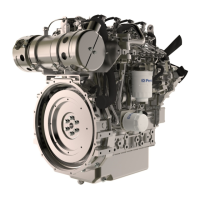NOTICE
Dispose of used engine coolant or recycle. Various
methods have been proposed to reclaim used cool-
ant for reuse in engine cooling systems. The full distil-
lation procedure is the only method acceptable by
Perkins to reclaim the coolant.
For information regarding the disposal and the
recycling of used coolant, consult your Perkins dealer
or your Perkins distributor.
Flush
1. Flush the cooling system with clean water to
remove any debris.
2. Close the drain cock or install the drain plug in the
engine. Close the drain cock or install the drain
plug on the radiator.
NOTICE
Do not fill the cooling system faster than 5 L
(1.3 US gal) per minute to avoid air locks.
Cooling system air locks may result in engine
damage.
3. Fill the cooling system with clean water. Install the
cooling system filler cap.
4. Start and run the engine at low idle until the
temperature reaches 49 to 66 °C (120 to 150 °F).
5. Stop the engine and allow the engine to cool.
Loosen the cooling system filler cap slowly to
relieve any pressure. Remove the cooling system
filler cap. Open the drain cock or remove the drain
plug on the engine. Open the drain cock or remove
the drain plug on the radiator. Allow the water to
drain. Flush the cooling system with clean water.
Fill
1. Close the drain cock or install the drain plug on the
engine. Close the drain cock or install the drain
plug on the radiator.
NOTICE
Do not fill the cooling system faster than 5 L
(1.3 US gal) per minute to avoid air locks.
Cooling system air locks may result in engine
damage.
2. Fill the cooling system with Extended Life Coolant
(ELC). Refer to the Operation and Maintenance
Manual, “Fluid Recommendations” topic
(Maintenance Section) for more information on
cooling system specifications. Do not install the
cooling system filler cap.
3. Start and run the engine at low idle. Increase the
engine rpm to high idle. Run the engine at high
idle for one minute to purge the air from the
cavities of the engine block. Stop the engine.
4. Check the coolant level. Maintain the coolant level
within 13 mm (0.5 inch) below the bottom of the
pipe for filling. Maintain the coolant level in the
expansion bottle (if equipped) at the correct level.
5. Clean the cooling system filler cap. Inspect the
gasket that is on the cooling system filler cap. If
the gasket that is on the cooling system filler cap is
damaged, discard the old cooling system filler cap
and install a new cooling system filler cap. If the
gasket that is on the cooling system filler cap is not
damaged, use a suitable pressurizing pump to
pressure test the cooling system filler cap. The
correct pressure for the cooling system filler cap is
stamped on the face of the cooling system filler
cap. If the cooling system filler cap does not retain
the correct pressure, install a new cooling system
filler cap.
6. Start the engine. Inspect the cooling system for
leaks and for correct operating temperature.
i04408743
Cooling System Coolant Level
- Check
Engines With a Coolant Recovery
Tank
Note: The cooling system may not have been
provided by Perkins. The procedure that follows is for
typical cooling systems. Refer to the OEM
information for the correct procedures.
Check the coolant level when the engine is stopped
and cool.
NOTICE
When any servicing or repair of the engine cooling
system is performed, the procedure must be per-
formed with the engine on level ground. This will al-
low you to accurately check the coolant level. This
will also help in avoiding the risk of introducing an air
lock into the coolant system.
62
SEBU7992-05
Maintenance Section
Cooling System Coolant Level - Check

